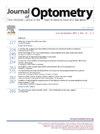Longitudinal change in central corneal thickness among primary schoolchildren
IF 1.8
Q2 OPHTHALMOLOGY
引用次数: 0
Abstract
Purpose
To investigate the longitudinal changes in corneal thickness and its contributing factors in primary schoolchildren.
Methods
This study is a part of the Shahroud Schoolchildren Eye Cohort Study, conducted longitudinally in two phases; in 2015 and then in 2018. Participants were tested for uncorrected visual acuity, best-corrected visual acuity, cycloplegic refraction, biometry, and Scheimpflug corneal imaging.
Results
After applying the exclusion criteria, 8782 eyes from 4432 participants were analysed. Of these, 2309 (52.1%) were male. Average three-year changes in central corneal thickness (CCT) and corneal apex thickness were −0.58 (95% CI: −0.94 to −0.22) and −0.59 (95% CI: −0.95 to −0.23) microns, respectively. There was an increase of 8.63 (95% CI: 8.1 to 9.17) microns in the superior corneal thickness after three years while the inferior corneal thickness decreased by an average of −5.75 (95% CI: −6.3 to −5.2) microns. The multiple generalized estimating equation (GEE) model showed that the three-year changes in the CCT were lower in rural than in urban students (β = −1.71; p < 0.001). Moreover, the baseline CCT (β = −0.04; p < 0.001), anterior chamber depth (β = −1.6; p = 0.003), and corneal diameter (β = −1.18; p < 0.001) had a significant inverse association while the body mass index (β = 0.12; p = 0.002) and axial length (β = 0.84; p < 0.001) had a significant direct association with the 3-year changes in CCT. After three years, CCT decreased by advancing age in boys, while remaining almost constant in girls.
Conclusion
The 3-year change in CCT was clinically negligible and could indicate its stability in schoolchildren. However, CCT thinning was more remarkable in urban students.
小学生角膜中央厚度的纵向变化
目的探讨小学生角膜厚度的纵向变化及其影响因素。方法本研究是shahoud学童眼部队列研究的一部分,纵向分为两个阶段;2015年和2018年。受试者接受未矫正视力、最佳矫正视力、睫状体麻痹性屈光、生物测量和Scheimpflug角膜成像测试。结果采用排除标准后,对4432名参与者的8782只眼睛进行了分析。其中男性2309例(52.1%)。角膜中央厚度(CCT)和角膜顶点厚度的三年平均变化分别为- 0.58 (95% CI: - 0.94至- 0.22)和- 0.59 (95% CI: - 0.95至- 0.23)微米。三年后,上角膜厚度增加了8.63 (95% CI: 8.1至9.17)微米,而下角膜厚度平均减少了5.75 (95% CI: - 6.3至- 5.2)微米。多元广义估计方程(GEE)模型显示,农村学生CCT的3年变化低于城市学生(β = - 1.71;p & lt;0.001)。此外,基线CCT (β = - 0.04;p & lt;0.001),前房深度(β =−1.6;P = 0.003),角膜直径(β = - 1.18;p & lt;0.001)与体重指数呈显著负相关(β = 0.12;P = 0.002)和轴长(β = 0.84;p & lt;0.001)与CCT的3年变化有显著的直接关联。三年后,有条件现金转移治疗在男孩中随着年龄的增长而减少,而在女孩中几乎保持不变。结论CCT的3年变化在临床上可以忽略不计,可以表明其在学童中的稳定性。然而,城市学生的CCT变薄更为显著。
本文章由计算机程序翻译,如有差异,请以英文原文为准。
求助全文
约1分钟内获得全文
求助全文

 求助内容:
求助内容: 应助结果提醒方式:
应助结果提醒方式:


